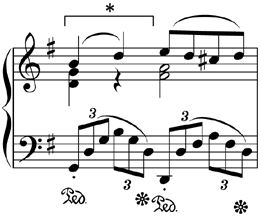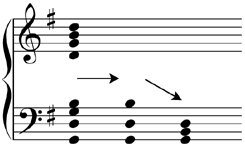Identifying Triads From Chords
How to identify the inversion and degree of a triad
Identifying triads is a fundamental skill in both the theory and performance of music: the inversion and degree of a triad tells us a lot about the harmony at a given moment in the music.
However, before identifying a triad, we actually need a triad, and most music is not so conveniently written! We first need to reduce the relevant music to the form of a triad, and one technique is the subject of this tip.
I recommend a simple three-step process:
Step 1: Combine
Combine all the notes into a single chord - only necessary if the music in question isn't already a single chord! Keep all notes in their original octave and clef.
Step 2: Eliminate
Starting from the bottom note up, eliminate any duplicate notes. This should leave you with just three notes, perhaps spread quite widely. Be careful if you are dealing with a chord spread over several staves or clefs.
Step 3: Transpose
Now transpose the two notes above the bottom note down by as many octaves as possible, into the same stave and clef as the bottom note, without going below the bottom note.
You should now have a recognisable triad, so identify it as usual, bearing in mind the key of course.
Here is an example question (the music is from the Rondo of Beethoven's Sonata op. 31 in G major).
| Q. Identify the triad described by the indicated section of music. The key is G major. |
|---|
 |
Watch out - a trap!
The trap in this question would be to look at the obvious triad in the upper stave and to give the answer "Ic" or "second inversion triad on the tonic". As we will see when we follow the three-step process, this is wrong!
So let's follow the three-step process:
|
|---|
 |
We can now see that the triad we're left with is a root position triad, not a second inversion triad: so the correct answer is Ia or "root position triad on the tonic"
Quick Quiz
Here's an extra quick question for you, which you should be able to answer from the Beethoven example alone:
Q. What instrument was this music written for?
Answer: The piano
You can tell that the music is written for the piano because it is written over two staves (known as a "grand staff") and you can see pedalling symbols.
The next Clements Tip will be with you soon — keep an eye on your inbox!
Not a subscriber? Get your FREE 40-part email course here
Did you like this tip?
You'll find lots more on the Clements Theory website:
- 80 step-by-step study guides from the basics to Grade 5 and beyond
- Revision questions to test your comprehension of each guide
- Over 7000 practice questions organised by difficulty and topic
- The Clements Q&A — rapid assistance from a music theory expert!
- Track your progress with the clever Clements Theory tools: see instantly where you are improving and where you need to practice more
Clements Theory is perfect for anyone studying for Associated Board or Trinity College Theory of Music Exams (Grades 1 to 5), and for GCSE or A Level Music.
“I've finished my theory exam and passed with Distinction,
thanks so much for your help!! ”
— Carmen Guthrie
Clements Theory user and successful Grade 5 Theory candidate
“Thank You, I have passed my theory exam,
I found Clements Theory very helpful!”
— Stephanie Hunter
Clements Theory user and successful Grade 5 Theory candidate